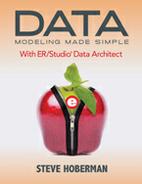Importing into ER/Studio
In addition to all of the databases that you can reverse engineer into ER/Studio, there are over 100 different formats that can be imported into the tool. You can even import from other data modeling tools, such as CA ERwin Data Modeler® and SAP Sybase PowerDesigner®.
To import, choose one of the following commands:
|
Menu |
Toolbar |
Explorer |
Shortcut Key |
Shortcut Menu |
|
File > New…, then Import Model From or File > Import File |
Application toolbar: |
n/a |
<ALT + F>, then <N> or <ALT + F>, then <M> |
n/a |
|
Become an ER/Studio Hotshot: · Recall from Chapter 13, Macros, that there are also lots of macros where you can import portions of the model from Excel. | ||||
Importing from External Metadata
If you selected From External Metadata…, the first of three screens appears, as shown in Figure 14.1.
Figure 14.1 Import External Metadata Page 1 of 3

Choose the type of input source from the drop down list. I chose to import a data model from CA ERwin Data Modeler version 7.x. After making a selection, click on the rectangle with the three dots to select the file you would like to import. On this screen, you are also provided with tips for importing from the format you selected. In this case, it is recommended to first convert the ERwin model to an XML format. I opened a data model in ERwin Data Modeler and saved it in XML Repository format, and then selected this file. See Figure 14.2 for the data model in native ERwin format.
Figure 14.2 ERwin data model to be imported into ER/Studio

You can click on any of the values, such as As metadata, migrate default values, and a drop down appears allowing you to select a different value. Tips appear for each selected row. On this screen, let’s keep all of the other defaults, and click <Next> and the screen in Figure 14.3 appears.
Figure 14.3 Import External Metadata Page 2 of 3

More settings that you can change appear, with tips appearing below as in the prior screen. Click <Next> to arrive at the final screen, shown in Figure 14.4.
Figure 14.4 Import External Metadata Page 3 of 3

There are different status and error codes provided during import. Any statements prefaced by green or blue circles represent status or information, and anything in red, such as orange and red triangles or red circles are warnings or error messages that will need to be addressed before importing. If you want to return to these messages, you can save them to a file by clicking <Save to File…> or print them by clicking <Print…>. Click <Finish> to complete the import process and view your model in ER/Studio, as shown in Figure 14.5.
Figure 14.5 ER/Studio model of ERwin imported model from Figure 14.2

Importing from an ERX File
An ERX file is an ERwin file created in CA ERwin Data Modeler version 3.x. Select the appropriate file and follow the instructions. Similar to importing from external metadata, you will have the option to save or print the log file. When done, click <Close> and save the new model. Note that CA ERwin Data Modeler version 3.x is a very old version of ERwin, and therefore it is unlikely you will use this function. Remember to use the Import External Metadata wizard discussed in the previous section when importing data models created in a more recent version of CA ERwin Data Modeler.
Importing from a SQL File
This was covered in the reverse engineering discussion in Chapter 10.

